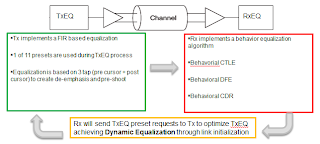 |
| Figure 1: An overview of the elements of PCIe 3.0 dynamic link equalization |
You need to test, we're here to help.
You need to test, we're here to help.
14 November 2014
An Under-the-Hood View of PCIe 3.0 Link Training (Part I)
10 November 2014
PCIe 3.0 Dynamic Link EQ: De-Emphasis, Preshoot, Cursors, and Presets
 |
| Figure 1: De-emphasis, a key transmit-side equalization technique for PCIe 3.0, boosts high-frequency content |
06 November 2014
The Hows and Whys of PCIe 3.0 Dynamic Link Equalization
 |
| Figure 1: SI problems are the root cause for dynamic link equalization in PCIe 3.0 |
Subscribe to:
Posts (Atom)